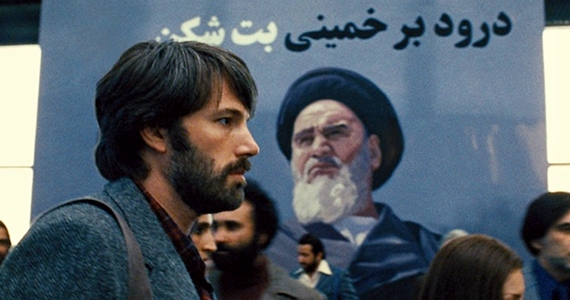ARGO seen through the prism of history
“Argo” is a great thriller, well-acted (special kudos to John Goodman and Alan Arkin), with spectacular cinematography in an Istanbul passing off as Tehran and a nail-bitingly suspenseful last half-hour (see Craig Younkin’s REVIEW). Incredibly, the far-fetched story really happened. The year is 1979 with Iran’s Islamic Revolution in full swing. In November, when the terminally ill Shah who has left Iran months before is allowed into the United States for humanitarian reasons, the wild-eyed bearded revolutionaries who overthrew him scale the walls of the U.S. Embassy and take the American staff hostage. Six of these manage to escape and make their way to the Canadian Ambassador’s residence, a haven safe only as long as the Islamists don’t realize that not all diplomats are accounted for.
The CIA scrambles for a way to bring them home until one daring “exfiltration” specialist comes up with a plan so absurd it can only succeed: pass off the diplomats as a Canadian film crew scouting locations for a sci-fi film. Never mind how implausible that would appear to Iranian authorities in charge of delivering permits for the crew to do its work, it’s a desperate last measure.
It is to Ben Affleck’s credit that although we know things will go as planned in the film as they did in reality, we are kept on the edge of our seat as one setback follows another. Where the director treads on more shaky ground is the history behind the story. Is this important? Does it matter? It certainly does, if only to avoid snap judgments and paint historical figures with a simplistic brush.
Seeking to establish context, the preamble in “Argo” describes a pre-revolutionary time, 1953 to be exact, where a “democratically elected leader,” Mohammad Mossadegh, was overthrown by a coup from the CIA who installed in his place a puppet devoted to the West, Mohammad Reza Pahlavi. The Shah, we’re told, lived a lavish lifestyle, had his meals flown in from France on the Concord while his people starved and died on the streets or under torture at the hands of his secret police, Savak.
This historical chestnut has unfortunately been making the rounds forever. Even President Obama has repeated it time after time and apologized to the Iranian people for American interference. (In one retelling, to the New Yorker’s Jeffrey Goldberg, he actually called Mossadegh “Iran’s democratically elected president,” instead of prime minister.)
This may make good copy or good cinema but doesn’t reflect the reality of what happened, which is far more complex. First of all, the CIA did not “install” the Shah who had already been on the throne since 1941, that is, for twelve years, replacing his father who had been sent into exile by the British. Mossadegh was appointed PM by the Shah, not democratically elected, though he received a vote of confidence from the Iranian Parliament with a quorum of seventy-nine representatives, the lowest possible number. A tug-of-war followed, with the ambitious PM (patriotic and rightly determined to keep Iran’s wealth, its oil, out of the hands of the British) butting heads over strategy with a young and impressionable Shah and establishing alliances with a number of unsavory characters, from communists to mullahs. After a while, he was asked to step down, yet reappointed in 1952, where he governed by martial law, hardly a democratic process, until he was overthrown. That coup, yes, was certainly funded by U.S. and British secret services but also bolstered by a certain amount of popular uprising.
Regarding the Shah himself, not only was he not the Oriental potentate eager to fill his own pockets, flatter Western powers and eliminate his opponents but quite to the contrary, he was obsessed with making Iran the most advanced country possible and his people educated, well-off and successful. Any cursory search will list his achievements in turning Iran into a modern state, such as women’s rights that even the ayatollahs have not been able to take away entirely.
[This article was also published on iranian.com — click here]
Unfortunately, the Shah was suspicious of an opposition which, as conspiracy-minded as any Mid-Eastern, he saw as fuelled by enemies of Iran such as the Soviet Union. In a hurry to reach his goals, the means became less important. As he told David Frost in one of the last interviews he gave, he put himself above the fray, calling repression and torture “petty details.” This is all the more unforgivable because he was the opposite of a bloodthirsty tyrant.
After the revolution of 1979, Paul Balta of the leftist newspaper Le Monde, no friend of the Shah’s, put the total number of executions under Mohammad Reza Pahlavi’s 37-year reign at less than 400, including criminals and drug lords. To put things in perspective, we should note that the Islamic Republic, in its three decades in existence, has killed tens of thousands of Iranians, not counting the hundreds of thousands killed in the eight-year old conflict with Iraq. But there is a major difference: The Shah wanted Iran to be respected and admired and considered civilized, which means sticking to the principles of civilized governments, which he didn’t, whereas the Islamic Republic doesn’t care.
Still, a trickle started a while back, growing into a steady stream, of a change of opinion regarding the Shah. He is being pulled out of the gallery of 20th –century rogue despots where he had been stuck, so that he is no longer considered in the same light as Bokassa or Pol Pot or Duvallier but gradually recognized as a leader who had a flawed albeit deep love of his country. Also, like Affleck but with more dire consequences, he wasn’t a student of history. Had he been, he would have known that people who are forcefully driven toward a goal, worthy as that goal may be, will end up rebelling.

The Shah and the Shahbanou of Iran






